
We are happy to present a guest blog by Dr. Thant Thaw Kaung, Executive Director, of the Myanmar Book Aid and Preservation Foundation (MBAPF):
It’s easier to get on show business, the hard part is to stay there. Nobody stays famous forever.
— Chris Rock
We are seeing so many people are enthusiastic to open new libraries these days in Myanmar, however very few are committed to maintain them until they become successful. Myanmar Book Aid and Preservation Foundation (MBAPF), a not-for-profit, non-governmental organization which is a library advocacy and support local organization, has been helping hundreds of Myanmar public and school libraries since its launching year in 2008.
Over the past 10 years, we have been donating books to over 900 libraries and helping to modernize 150 public libraries and nearly 100 school libraries. The objective of this article is to show what are the key factors in maintaining the libraries in business.
In other words, dos and don’ts for sustaining public libraries are going to be discussed, based on our pragmatic experience in Myanmar.
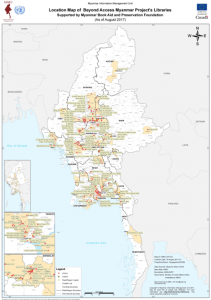
Map of Myanmar showing where Beyond Access projects took place
Brief History of Public Libraries in Myanmar
Myanmar has literacy rates of over 90%, is one of the highest among Southeast Asian countries. This can be due to the fact that Myanmar has a strong monastic education system even before the British annexation (from 1886-1948). Education is given high priority in Myanmar culture.
However, successive military governments have neglected education and hence those who are born after 1960s are facing many challenges in getting a good education. At the same time, the role of public libraries were downgraded and they were used only as a propaganda arm of the government under the socialist and military government.
However, thousands of community based libraries were unofficially set up after the year 2000. This means that they cannot get official registration status by the government. From 2006 to 2010, government promoted the opening of thousands of public libraries and even forced local people to have one library in each village. In short, the government went for “number or quantity” than “quality”.
At one point, the government used to boost that Myanmar had 55,755 libraries across the country but in reality, there were only 6,000 public libraries. Many of them closed down, as they were unable to offer a proper service and they did not match with community needs.
MBAPF and The Asia Foundation conducted a survey on “Landscape survey of Myanmar public libraries” in 2013 and found out that only about 6,000 libraries really exist. Out of that number only about 440 public libraries were run by the Information and Public Relations Department under the Ministry of Information, with the rest all operated under local communities. Community libraries are operated by volunteer youths, influential persons from the community, monks, village leaders and literary advocates.
Beyond Access Myanmar Project for Public Libraries
With the liberalisation and reform of the telecom sector in 2011, the people of Myanmar started to enjoy an affordable internet. In 2013, MBAPF launched the Beyond Access Myanmar project with a US based developmental organization called IREX (Information Research and Exchange), Ooredoo Myanmar and the government’s Ministry of Information.
Beyond Access Myanmar supported three main facilities; free internet and devices sponsored by Ooredoo Myanmar as CSR project and capacity building training were arranged by IREX. In 2015, we were fortunate to engage with University of Washington (Seattle, USA) and were able to develop a curriculum called Mobile Information Literacy (MIL) which matches directly with community needs as over 80% of people go online with their smart phones.
Just five years on, there are nearly 300,000 people using tablets and over 30,000 people who surfed the internet for their first time in their lives. According to monthly surveys, 45% of people said that they look for the latest news and information, 32% says that they would like to access digital literacy skill training at the libraries, and another 23% says that they would like to get better jobs. Beyond Access Myanmar has been implemented with regard to the following global public library trends:
- Libraries for everyone
- Technology hubs in the digital world
- Libraries are welcoming
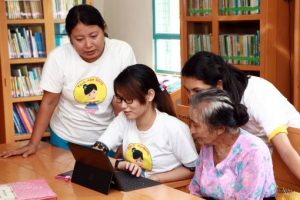
Tech Age Girls Project, Myanmar
Around 2015, we learned that the ratio of technology users at libraries between boys and girls is 2:1. Therefore, IREX and MBAPF launched another project called Tech Age Girls (TAGs) Myanmar project which is designed to train technology, leadership skills, soft skills and project management skills to girls aged between 16-20 through our Beyond Access Myanmar library network.
Each year, 100 TAGs were trained in competition style through 20 libraries (5 TAGs from each library). 20 outstanding TAGs were invited to Yangon to meet with women leaders from civil society, politics and entrepreneurs so that these TAGs become active women leaders. At the end of the project, each of them has to implement a community project which can be of benefit to their communities.
A wide range of community projects were carried out, ranging from technology trainers at community centres, and some active women leaders have been operating mobile libraries. Many of these TAGs become trainers at their respective libraries. In other words, one year’s trainees become next year’s trainers. They even volunteer to run TAG projects, even without our support, because they feel that this is what they need in their community. In other words, ownership was developed among the TAGs.
By the end of 2017, IREX’s sponsorship on Beyond Access Myanmar ceased. However, MBAPF was able to find other partners such as Microsoft, ISIF Asia, Ooredoo Myanmar and sponsors to continue the project. Therefore, from 2013 to 2018, Beyond Access Myanmar has maintained its momentum and even scaled up from 55 libraries to 150 libraries across the country.
I will now discuss what are the success factors of Beyond Access and public libraries in Myanmar. Even though IREX support on Beyond Access has ceased, we are continuing other projects with IREX. For example, IREX and MBAPF partnered to launch a project in 2018 called “Navigator” which is providing information via traditional means as well as through Facebook Chatbots to migrating workers (including already migrant workers) to get the right information through our rich Myanmar community libraries.
Let’s Read Project for School Library Revitalizing Project
RoomToRead, a well-recognised international development organisation which provides support to many schools globally, chose MBAPF as its local partner for revitalising school libraries in Myanmar. This project was launched in collaboration with the Myanmar Library Association, MBAPF, the Ministry of Education, Daw Khin Kyi Foundation and RoomToRead in 2017.
The initial pilot project was targeted at 20 school libraries, but now reaches 71 libraries after just one year, with collaboration from other partners and sponsors. Myanmar has over 47,000 schools out of which just over 26,000 have separate library rooms. Moreover, there has not been any teacher librarian training even though some schools have allocated one teacher as librarian, but they cannot handle the library properly as their duties are overloaded with teaching. This is why most of the school libraries are barely active.
Public or community libraries should have the following factors to ensure the sustainability of their libraries. These factors also apply in other types of libraries such as school libraries, academic libraries and special libraries.
- Fresh resources
- Regular activities
- Ownership
- Partnership
- Capacity building to librarians
- Monitoring and Evaluation
- Institutionalization
- Fresh Resources
Resources are needed for books, periodicals, facilities and even staff. Newly arrived books (fresh books) are needed all the time. The decoration of the room, book shelves and reading tables have to be fresh and attractive. Staff or librarians have to be welcoming and attentive to the users.
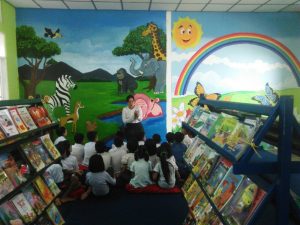
Let’s Read Project, Basic Middle School No. 7, Innsein
When we launched the “Let’s Read” project with RoomToRead, together with Ministry of Education, we split our budget for purchase of newly published books into 6 months apart so that we can buy new arrivals. Moreover, we tell the school libraries to display only 70% of the books that they receive and keep the remaining 30% in store. These books from store will have to be displayed 4 months later.
Furthermore, during the capacity building training and orientation to librarians, we emphatically informed the librarians that children are fast readers and that all the books in their libraries will be read by them in 6 months’ time. Therefore, they need to find ways how to get new books. Moreover, we always mentioned to our participating librarians that our normal project life cycle is around 2-3 years only. We will support the heavy duty of the initial setup phrase and after the project lifespan, they need to look out for ways to get continuous support.
Since librarians know in advance that our support won’t be there forever, they started to look for future supports from community support groups. In the case of school libraries, they started to talk to Parent Teacher Associations and School Support Groups. In most cases, they have been able to get fresh books without our support.
- Regular Activities
Another key factor in making libraries sustainable is to do regular activities or programmes. For example, if a community library or school library can arrange an activity or programme on a regular basis, they will attract people from the community and will have full support from them. Activities can be literary talks or book review discussions, or technology training or discussion at a community library. But the important thing here is the activity must be regular. For example, a community library can host a book review discussion on last Friday of every month.
In a school library setting, if students can spend one period a week at the library, librarians can tell stories or practice reading aloud or shared reading activities with students together. Again, this activity has to be regular. The best way is to put a library period in the curriculum or time-table of the school. MBAPF has been able to negotiate with the Ministry of Education to put one library period per week in all “Let’s Read” project school libraries. By doing this, students are already aware of their library period time and prepared to go there.
- Ownership
This is one of the major factors in making libraries sustainable. We always mentioned that any resources (books, furniture, shelves and digital devices) that we supported should belong to the community or school library. We mentioned up front that we will not be replacing devices or materials that were damaged or lost. In the case of books, we trained the librarians how to handle books carefully in order to avoid tearing them apart. In turn, librarians then show library users – especially children – how to flick through books with care. At the same time, ownership creates meaning – “These books belong to you and you need to handle with them care”.
We have reported of loss of only 5 tablets out of over 1,000 devices that we donated in past the 5 years. Moreover, librarians know that we won’t be there forever to support them and hence they need to find ways to support by themselves or need to stand on their own feet. They know that MBAPF will provide the initial heavy part only.
For example, we supported 4 tablets, free internet and training to a library in Mon State. Once the library received the tablets, they started to invite students from nearby schools. Since the community saw that so many students are using tablets, they raised funds to build a separate room for ICT training with 25 desktops. Our initial investment is only about USD 500 to this library plus training.
When we launched the “Let’s Read Project” for school libraries, we mentioned to principals and teacher librarians that we were going to support books, shelves, carpet, reading tables and training. Then, we asked what sort of things they can find from supporters to match our initial support. We showed a few slides of some good examples from Indonesia and Vietnam where RoomToRead library rooms were decorated with wall painting by Parents-Teachers Association and School Support Groups.
All the 20 pilot libraries agreed to do the same by decorating by themselves. In fact, we have a budget for decorating these rooms but since we were able to get matching support from the school’s side, we can reallocate this funding to purchase of more books and even expand our project size from 20 to 25 schools. With their own contribution from the schools’ side, they are taking more responsibility rather just accepting donation from sponsors.
At the same time, we asked principals and teacher librarians to ask students to volunteer at the school library. The principals have to acknowledge these volunteer contributions at the schools morning assembly time. This work is extremely successful as many students started to volunteer at the school by sorting out the books and also helping the checking-out of books. With the development of this sense of ownership, these school libraries can stand on their own feet. At present, some school libraries are even opening up on weekends to attract other community people and other students. This gives the reciprocal effect as many community people saw this good cause and they started to contribute books, shelves and reading tables.
- Partnership
Finding the right partners and maintaining the relationship is an art in this world. Libraries can not be sustainable if partnership is lacking. Partnership has to be transparent with mutual respect, the taking of responsibility and accountability. It can be bilateral or multi-stakeholder.
As MBAPF is a local Non-Governmental Organization, our partnership structure works along two dimensions. The first one is partners and sponsors who are willing to help our Myanmar libraries. They can be international developmental organisations, universities, corporations, government ministries and other local civil society organizations. The second one is partners who are willing to get support from us. We have to select carefully for those recipients from us as they have to meet the requirements of their local community. With these two dimensions, MBAPF acts efficiently and effectively to reach the goals of community as well as expectations of sponsors and partners.
The first dimension or supply side is based on trust building and transparency. MBAPF has to work constantly to look out for potential partners and sponsors of our project in order to ensure the sustainability of our projects. This can be made through participation in various conferences, workshops, presentations and meetings.
At the same time, we have to understand the objectives of these sponsors. For example, when we tried to look out for potential partners for free internet (data) and devices in 2013, we tried to meet with all the telecom operators in the country. Some operators are trying to set up telecentres and in fact, they have to invest heavily on infrastructure such as buildings. Therefore, we were able to convince Ooredoo Myanmar to use the existing infrastructure which Myanmar has as a hidden treasure of over 6,000 community based libraries. Ooredoo can even cut cost as they don’t have to build extra buildings.
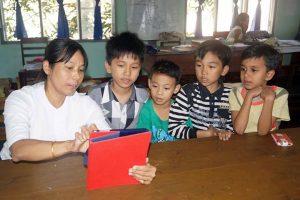
Participants in a Mobile Information Literacy class at Taungoo IPRD Library
In 2015, we engaged with the Information School and Technology and Social Change (TASCHA) from University of Washington. They have developed a digital literacy curriculum which we later customised into a Mobile Information Literacy curriculum, as over 80% of people in Myanmar go online using their smart phone. In other words, we always try to match with demand side of the equation.
At the same time, we have to know our areas of strength also. When we were developing out school library revitalisation project under the Let’s Read project, we had to build a support group in communities where teacher librarians needed help. Through this, we have already developed our Beyond Access Myanmar library project and we can identify strong and outstanding community librarians who can work with nearby schools. We can even identify a lot of useful information from community librarians about which schools have open- minded people and which schools are passionate about school libraries. That is why, we were able to select our initial 20 pilot school libraries. We are really grateful for our community librarians’ input into this.
The second dimension or demand side is also hugely important. The size of libraries, the number and type of members that they are serving, what programmes they are running, the presence of ICT tools and a scalable model are all important points to consider whether a community library can be a recipient of sponsorship.
MBAPF gives highest attention to human factor involvement of a community or school library. This includes commitment and passion from librarian (in case of school library, commitment from principal as well), openness to new ideas, and a will to work with other community networks (in case of school libraries PTA and School Support Group as well). These factors will decide the success or failure and at the same time the sustainability of a library. I describe partnership is an art because it is very delicate.
With the right partnership from both supply and demand side, we have seen so many success stories. When we launched Let’s Read project in 2017, we have already had a very good network of community libraries since we have been working with them since 2013. Therefore, we have partnered with active community libraries to carry out the Monitoring and Support trips to schools which are located close to them. This partnership of community and school library works very well as schools are willing to accept community support as they are short of resources, given that they don’t have trained school librarians.
We also gave training to community librarians on digital and information literacy. They in turn have become our master trainers and cascade their learning to others. These community libraries are trusted organisations and hence when we launched the Tech Age Girls Myanmar project, we had full support from parents and community as well. When we launched the “Navigator” project for safe migration, community libraries played a key role in partnering with local service providers such as the trafficking police, trade unions, legal aid organisations and other activists who are willing to help migrant workers to get right information.
For example, we conducted a workshop in Bago region in September 2018, where our community librarians are helping victims of people trafficking who are based in Thailand to get compensation from an agency with the help from a trade union.
- Capacity Building to librarians
21st century librarians have to know 3 main topics of capacity building. These are 1) technical 2) technology and 3) soft skills. Technical skills include the traditional skills of cataloguing and circulation skills. However, librarians have to understand to use electronic library automation systems.
Technological skill is different from technical skill as it consists of digital and information literacy skills. For example, a librarian should be able to search for authentic information from Google Scholar for their users. This is a technological skill.
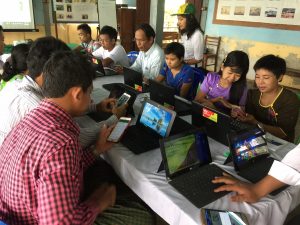
Communication for Development Training in Htan Tapin
The last skill is soft skills which include customer service skills, communication skills, marketing skills, presentation skills and so on. We often fail to look into technological and soft skills as most of librarians’ training is concentrated on traditional technical skills.
At the same time, any training that we give has to meet local demand and be applicable in the local context. All our training is localised and delivered in the local language only. For example, the Mobile Information Curriculum has been localised and has been given to over 5,000 community people through our library network. The demand for Media and Information Literacy (MIL) is so strong that nowadays we have to give MIL to other sectors such as civil societies, civil servants, university students and research firms.
- Monitoring and Evaluation
In all of the work we do, there are checks and balances system in place. We have to understand whether our projects are being carried out properly or not. We are, in fact, more eager to learn about challenges than success stories so that we can improve ourselves. In our Beyond Access Myanmar project, each library has to submit monthly reports via Survey Monkey. Indicators include number of users, types of users, types of programmes, and whether there is any support and collaboration from local or national organizations . These data are analysed and put into our report and shared among our partners and potential sponsors as well. By doing so, we will know which libraries are doing well and which ones need help.
In case of our school library ‘Let’s Read’ project, we have even tried to avoid the usage of monitoring and evaluation. We call it monitoring and support. The reason to avoid calling it ‘evaluation’ is that we do not want teachers to feel that we are auditing them as they are already overloaded with a lot of work, both because of their teaching and library work.
- Institutionalization
Due to the nature of grants from international developmental agencies, each cycle lasts for 2-3 years. These sponsorships have allowed for the first heavy life, and now the challenge is to find ways to get a sustainable model.
In the case of public and community libraries, IFLA, IREX, the Myanmar Library Association and the Ministry of Information helped MBAPF to draft a master plan for public libraries which become a precursor for the Public Library Law in Myanmar. We were able to mention all the requirements of community libraries to become a modern community centres in the master plan. At the same time, MBAPF signed a Memorandum of Understanding agreement with the Ministry of Information to get a sustainable model for public libraries in Myanmar.
MBAPF is about to sign a Memorandum of Understanding with the Ministry of Education to roll out a consistent school library development system to the rest of the schools in the coming year. This MoU covers how to setup and manage a proper school library, teacher librarian training, selection of books, how to engage with the community and most importantly how to conduct monitoring and support for the implementing schools. We have invited officials from both the Ministry of Information and the Ministry of Education to take part in all our trainings so that they can carry on even after our projects end. In other words, institutionalisation is one of the key factors in sustainability of libraries.
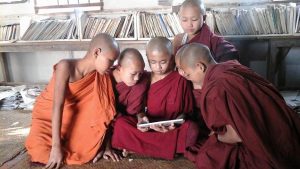
Tharsi Quarter Library
Conclusion
Even though I have been discussing the above mentioned seven points separately for the sustainability of libraries in Myanmar, there are many connections between them. For example, in order to get fresh books, librarians have to partner with local publishers and parent-teachers associations. We have full confidence that libraries will be sustainable with the effective implementation of these points.
Finally, I would like to point out that no matter how advanced technologies are in the 21st century, basic human factors of passion, dedication and commitment will bring sustainability of libraries in Myanmar and elsewhere.